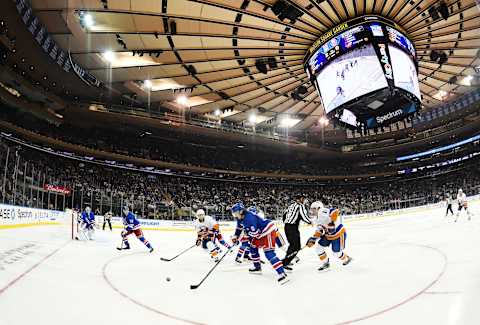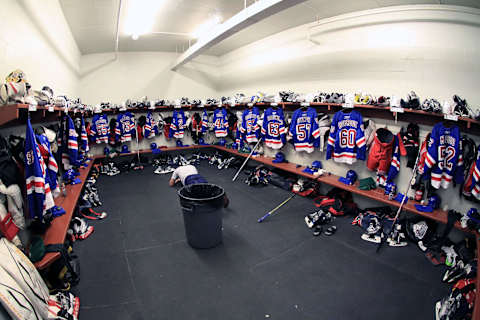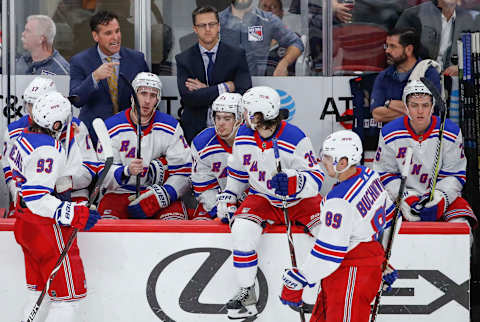What the return to play plan means for the Rangers

There are some unique issues facing the New York Rangers
The NHL Owners and the NHL Players Association have a tentative agreement on a Return to Play plan, pending an approval vote. With a plan set for a 56 game season beginning on January 13, it will affect various teams in different ways. Here’s how it impacts the Rangers.
A tough division
The divisional structure is set, although there are still issues in Canada. Right now, the Rangers will be in an eight team division with Boston, Buffalo, New Jersey, Islanders, Philadelphia, Pittsburgh and Washington. It’s acknowledged through the hockey world that this is the toughest of the four divisions.
To make matters even harder, only one team will come of the the division to make the Stanley Cup Semi-Finals. There appears to be no plan for expanded playoffs, it will be a dogfight to make it into the top four of each division followed by another dogfight to be the team that comes out of the division.
If the Rangers can make it to the final four, they will deserve it. In the meantime, it’s a division replete with longtime rivalries and there will be a lot of great hockey to watch. The Rangers will play each team eight times, four home and four away.
The last time teams played as many as eight times against any one team was in the 2007-08 season when the Blueshirts played teams in the Atlantic Division eight times.
The only question is in Canada where the NHL will have to get permission for teams to play and also travel between provinces. If that doesn’t happen, the Canadian teams will likely relocated to markets in the United States.
The Toronto Blue Jays played their home games in Buffalo this summer and the Raptors will be based in Tampa. That’s due to the restrictions on teams traveling into Canada. In the NHL’s case the league will need to get permission from local authorities in five provinces (Alberta, British Columbia, Manitoba, Ontario and Quebec) for them to play games.
If that doesn’t happen, the league will have to tear up the proposed divisional structure and start from scratch.

No exhibition games
Training camps will open on January 3 meaning that teams will have ten days to prepare for the season. There will be no exhibition schedule so teams with many lineup issues will be affected more than teams that have no questions. What are the issues facing the Blueshirts?
The Rangers have one line set going into training camp. Mika Zibanejad, Chris Kreider and Pavel Buchnevich will be a set first line. After that, nothing but options. Artemi Panarin will team with Ryan Strome, but need a right winger. Kaapo Kakko and Julien Gauthier are the likely candidates.
Depending on what happens with the Strome line, it will determine the rest of the forward lines. Alexis Lafrenière will be the left wing on the third line with Filip Chytil. The fourth line is completely open with a spirited competition among Brendan Lemieux, Kevin Rooney, Colin Blackwell, Brett Howden, Phil Di Giuseppe and rookie Morgan Barron.
Defense is even more of a question. The only set pair is Adam Fox and Ryan Lindgren, though the team has discussed trying Fox on the left side. It does mean that Brendan Smith goes into training camp with the longest track record as Jacob Trouba’s partner. Libor Hajek is the only experienced Rangers blueliner who has been playing (in the Czech Republic) and that may help him gain an edge.
It doesn’t help rookies like K’Andre Miller and Tarmo Reunanen who will not get much of a chance to win a job.
Lineup uncertainties will really affect teams when it comes to getting off to a good start.
The short season
The 56 game season will be longer than the two lockout shortened seasons (1994-95 and 20012-13) when they played 48 games. The NHL played 50 games or fewer before 1946-47 when it was a six team league. It’s still going to be essential for teams to get off to a good start. A slow debut and it could be fatal to any playoff aspirations.
The Rangers under David Quinn have not been quick starters. In 2018-19 the team was 10-8-2 after 20 games. Last season they were 9-9-2 after 20 games. After 56 games last season, they were 29-23-4. Their 62 points would have been for for sixth place in this new division.
Of course, this is a different Rangers team and last season the improvement was later in the season, but even if you look at the last 56 games of their 70 game season it wasn’t playoff worthy. They had a record of 30-22-4 over their last 56 games for 68 points.

The taxi squad
The roster limit will remain 23 players and the salary cap ceiling for those 23 players will be $81.5 million. All teams will be able to carry a taxi squad of four to six players who will be paid their AHL salaries, but will practice with the NHL squads.
Last season, the Rangers active roster was usually fewer than 23, in fact, at the end of the season they were carrying 19 skaters and three goalies. They had no spare defensemen on the active roster.
Today, the active roster is 23 including 14 forward and seven blueliners including players like Phil Di Giuseppe, Colin Blackwell and Tony Bitetto. It’s unlikely that they will go below that number considering the possibility of COVID-19 related quarantines.
A major question for the Rangers will be who will make up the taxi squad. With the AHL season due to begin on February 5, there won’t be an issue if they keep players like Morgan Barron, K’Andre Miller, Tarmo Reunanen or Libor Hajek with the big club (if none of them win a job on the roster), but when the AHL starts their season, it will be better for them to be playing regularly. At that point it will a question of who they keep and who they want to get meaningful game minutes in Hartford.
If the Rangers choose to send their younger players to Hartford, the taxi squad could be made up of players like forwards Tony Greco, Tim Gettinger and defensemen Brandon Crawley and Darren Raddysh.
Another question is whether teams will want to have three goalies with the team (one on the taxi squad). if they do, it’s a perfect role for Keith Kinkaid who was signed as a free agent.
The arenas
The plan is for teams to play in their home arenas, though the idea of a hub system is still an option if pandemic considerations require it. Since the Rangers will be playing in the northeast region, it’s doubtful that any of the teams in their divisions will be allowed to have spectators in the arenas. Without fans in the seats, teams won’t have any kind of home ice advantage.
Miss you. Mean it. 💙❤️ pic.twitter.com/mTwqECNvGV
— New York Rangers (@NYRangers) December 14, 2020

Yikes
There’s not a lot of time and many issues to work out. There were a number of Ranger players already working out in the area and most of the New York Rangers scattered around the globe are already making their way back to New York.
Someone's back in town. 👀
— New York Rangers (@NYRangers) December 15, 2020
Welcome back, Shesty! 🗽 pic.twitter.com/W3kIqL9ZYc
Ten days is not a lot of time for Jacques Martin to make his mark on the Rangers blue line corps, one of the keys to a successful season. It’s also not a lot of time for dark horse candidates to make the team. The good news for the Rangers is that they have a solid mix of veterans and experienced kids and not a lot of new faces.
While each NHL team will face their own set of unique issues, the Rangers are in pretty good shape overall, especially when it comes to the salary cap. Ten NHL teams are currently over the cap ceiling and will need to shed salary by the start of the season.
There are a number of prominent Restricted Free Agents who still need deals including Matthew Barzal, Casey Mittelstadt and Jesper Bratt just in the Rangers’ division and there is also a long list of Unrestricted Free Agents still looking for a home.
It’s going to be a very busy period for many NHL teams. The good new for the Blueshirts is that the challenges they face are related to the team that will take the ice on January 13 and not contractual or cap related.
More. Colin Blackwell report card. light